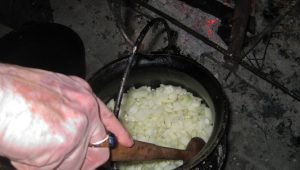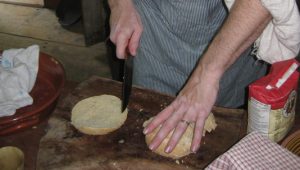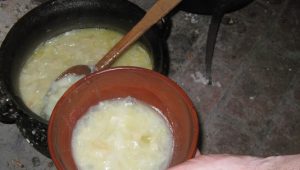 These articles have, to this point, focused on reproducing the meals of our Revolutionary-era forefathers with all of the conveniences of the modern kitchen. However, it is important to remember that the cooks of those days prepared all of these wonderful foods using wood fires and cast iron.
These articles have, to this point, focused on reproducing the meals of our Revolutionary-era forefathers with all of the conveniences of the modern kitchen. However, it is important to remember that the cooks of those days prepared all of these wonderful foods using wood fires and cast iron.
When Daniel O’Neil, Executive Director of the Ethan Allen Homestead Museum in Burlington, Vermont, invited me to do so–under the very roof that the leader of the Green Mountain Boys had erected for his own family after the conclusion of the American Revolution–I naturally leapt at the chance.
I was advised in this endeavor by an experienced Revolutionary-era re-enactor, Heather Kenyon-Haff, who greeted me at the homestead in full period garb to match what they provided for me to wear.
Onion Soup
Ethan Allen built his farmhouse in 1787 near the Winooski River, which derives its name from an Abenaki Indian phrase that means “Onion River,” after the wild onions that grew in profusion along its banks. Between that, and the desire to work with recipes that would be forgiving of uneducated hearth cookery technique, we decided to make a simple onion soup from Hannah Glasse’s formidable 1774 book The Art of Cookery Made Plain and Easy, Which Far Exceeds Any Thing of the Kind Yet Published.
Begin by building a nice fire in your hearth, regardless of the fact that it’s nearly 90° F (32° C) outside and you’re wearing wool and heavy linen (in multiple layers, in Heather’s case!). Once it’s reduced to a good bed of coals, you can suspend your soup pot over it. Or, if you’re following along at home, put a large saucepan over medium heat.
Melt in the pot, stirring occasionally until it has clarified:
1/2 lb (225 g) salted butter
Meanwhile, peel and chop:
5 lb (2.25 kg) onions
Add to the butter, stirring well. When I asked Heather for advice on what to do with the chopped onions in lieu of a kitchen full of handy bowls, she suggested sweeping them into a dishcloth as I chopped them. When it was time to add them to the pot, I was able to simply open up one corner of the cloth and pour them right in – and I will likely use this method even when I am back in my own kitchen, it was so convenient!
Sauté the onions until they are soft, about 15 minutes. Add:
4 tbsp (60 ml) flour
Cook for another few minutes, stirring to evenly distribute the flour.
Add:
6 cups (1.25 l) boiling water
Cut into small cubes:
3 cups (775 ml) stale bread
Add it to the soup with:
1 tsp (5 ml) salt, or more to taste
Now bring in more wood to heat the pot to the boiling point. (Or just turn up the heat on your stove, if you’d like to do it the easy way.) Boil for ten minutes, and then beat until frothy in a separate bowl:
2 egg yolks
1 tbsp apple cider vinegar
Slowly add a cup or two of the boiling soup into the yolks, continuing to beat them, until they are well tempered, and then gradually stir the egg mixture back into the soup. Serve hot with Hoe Cakes, below.
Hoe Cakes
These are really about the same thing as what is elsewhere known as Johnnycake, but they are cooked over a flat iron hoe or long-handled griddle. As we lacked a hoe, we used the blade of a shovel, which together with the smoke from the fire added a lovely touch of authenticity to the finished product.
Bring to a boil:
1 1/2 cup (350 ml) water
1/2 tsp (3 ml) salt
Remove water from heat and stir in until thickened:
1 cup (225 ml) cornmeal
Drop the batter onto a greased, heated cast iron griddle or a fireplace shovel and flatten slightly with a wooden spoon. Cook until lightly browned, then turn and cook the other side.
Thanks again to the fine people at the Ethan Allen Homestead Museum – this was a deep honor and a spectacular opportunity to gain a better first-hand understanding of the hard work that went into the daily chores of putting food on the table during the American Revolution. If you’re ever in the Burlington, Vermont area, do make time to stop by – they’re doing a terrific job of keeping the feeling of the American Revolution time within reach.













Recent Articles
Teaching About the Black Experience through Chains and The Astonishing Life of Octavian Nothing
Review: Philadelphia, The Revolutionary City at the American Philosophical Society
Joseph Warren, Sally Edwards, and Mercy Scollay: What is the True Story?
Recent Comments
"James Lafayette (James Armistead),..."
Hi Ken, Thank you for this article! I thought you might like...
"The 1779 Invasion of..."
Sorry I am not familiar with it 2 things I neglected to...
"“Good and Sufficient Testimony:”..."
I was wondering, was an analyzable database ever created? I have been...